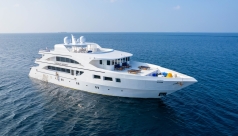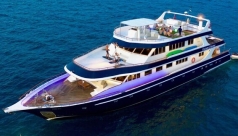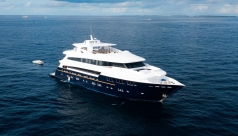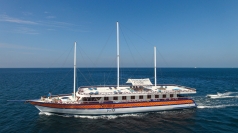Dive Destinations
Liveaboards
Resorts / Day Trips
Scuba Training
...Highlights: whale sharks, tiger sharks, hammerheads, shark action, manta rays, schooling fish & big pelagics...
...Diving environment: healthy reefs, advanced divers, off the beaten track...
A small and isolated atoll island located on the equator in the Deep South of the Maldives, Fuvahmulah is gaining a diving reputation as The Place to be in Asia for encounters with oceanic megafauna - that means plenty of adrenaline-filled dives with rare and large marine animals. Most notably this is where you can find the largest recorded numbers of tiger sharks in the world, but also hammerheads, threshers, oceanic whitetips, silvertips, whale sharks, oceanic mantas, even sunfish, sailfish and whales. That’s a very heady list!
What makes Fuvahmulah unique and one of the best places in the world for diving with sharks is its location and underwater topography. It is open to the vast Indian Ocean and its sloping reef extends deep towards the ocean. Large pelagic creatures are attracted up the slope for food, grooming and mating. Sharks have been protected in the Maldives since 2010.
There are around 20 dive sites at Fuvahmulah, including Razwa Faru and Farikede in the south, Thoondu Beach in the north, Rasgefaanu (for snorkeling), Neregando Fannu, and of course the infamous Tiger Zoo – the best place to see plenty of resident tiger sharks throughout the whole year.
The hard coral reefs here are healthy and full of life, with some enormous schools of barracuda, yellowfin tuna, bonitos. And if you can tear your eyes away from the big stuff, you would find that there are also smaller creatures too, such as squid and cuttlefish, snakes, crabs, mangrove rays, and nudibranchs. Mostly the island remains untouched by the seasonal changes elsewhere in the Maldives.
Tiger Zoo is the most famous dive site in Fuvahmulah, and this is where divers can regularly encounter tiger sharks, sometimes dozens of them, throughout the entire year. They are easily identified by the dark stripes down their flanks and their huge size - growing up to 5m and 900 kg. The sharks are attracted to the shallow waters here by the waste fish products discarded by local fish market and fishermen as they return to harbour. The tiger sharks are not fed here, rather they play an important role in the eco-system in consuming corpses and sick or injured animals.
They are a requiem shark and have a reputation for being aggressive and highly dangerous to humans. However, there have been no recorded incidents of any shark attacks in Maldives. Tigers may often come close to scuba divers due to their natural curiosity, but this is a thrilling experience rather than life-threatening. However, whether you dive here by liveaboard or from a nearby resort, dives are accompanied by local experts who have vast experience of diving with these sharks, observing safety rules and sharing tips on shark behaviour.
Another shark rarely seen by divers is the deeper water thresher shark. Here in Fuvahmulah, there are several relatively shallow water cleaning stations (12-15m deep) that threshers use, most consistently between April and November. These elusive sharks are easily identifiable by their long sickle-shaped tail fin and are listed as ´vulnerable´ by the IUCN Red List. Lucky divers at can occasionally see them breaching at Fuvahmulah. Silvertip sharks are another star of the show here. Rarely seen elsewhere in the Maldives, these sharks can sometimes be encountered in their hundreds between January and March.
Hammerhead sharks are more commonly seen in the Maldives but here at Fuvahmulah divers can find both scalloped and great hammerheads. Scalloped hammerhead sharks are a common sight throughout the year and you can see them in large schools between January and March. Great hammerheads are more elusive but they are a terrific sight to behold when spotted at the deeper sites. Likewise, oceanic whitetips are occasional visitors from the open ocean.
Whale sharks are always a favourite sighting for divers, but such are the underwater riches at Fuvahmulah that they are sometimes overlooked in dive briefings. These gargantuan yet gentle giants can be found here all year round, but more commonly seen with juveniles between January and May. Grey reef sharks and whitetip reef sharks are resident and common encounters all around the island. Whitetips are usually found in the caverns with their young.
Another scuba diving highlight of Fuvahmulah Island are the oceanic giant manta rays. Elsewhere in the Maldives, it’s the smaller reef manta that is seen. However at Fuvahmulah, it’s their massive oceanic cousins that frequent the cleaning stations, including the very rare all-black variation. Then between March and May, these graceful pelagics arrive in their hundreds to mate, making Fuvahmulah one the world’s hotspots to see large congregations of oceanic mantas. Manta rays are thought to be highly intelligent and are often curious and playful toward scuba divers.
Apart from all the amazing shark action, you will see mobula rays, giant trevally, schools of barracuda, yellowfin tuna, and bonitos. From time to time, mola mola, sailfish and humpback and pilot whales pass by. What an amazing dive destination is Fuvahmulah Island!

Customer rating: Excellent!

Customer rating: Excellent!

Customer rating: Excellent!

Customer rating: Excellent!

Customer rating: Excellent!

Customer rating: Excellent!

Customer rating: Excellent!

Customer rating: Excellent!

Customer rating: Excellent!

Customer rating: Excellent!

Customer rating: Very good!

Customer rating: Very good!

Customer rating: Very good!

Customer rating: Very good!

Customer rating: Very good!

Customer rating: Very good!

Customer rating: Very good!

Customer rating: Very good!

Customer rating: Very good!

Customer rating: Good

Customer rating: Good

Customer rating: Good

Customer rating: Good

Customer rating: Good

Customer rating: Average

Customer rating: Average

Customer rating: Below average

Customer rating: Be first to rate!

Customer rating: Be first to rate!

Customer rating: Be first to rate!

Customer rating: Be first to rate!

Customer rating: Be first to rate!

Customer rating: Be first to rate!
5 - 40m
20 - 30m
Moderate to strong
Usually calm
25 - 30°C
Intermediate to advanced
20
500 km south of Male
3-7 days
I am always impressed with how quickly Vic responds to EVERYTHING. Having worked with Vic since 2015 to book our trips, my confidence in his responsiveness means that I'm more relaxed knowing that if anything comes up he'll be there for us if / when we need it. I also want to call out how helpful he was in 2020 when we needed to cancel our trip and get a refund exception, given that we were saving for our wedding. He helped work with the operator for an exception, and his extra effort really made such a difference to us. I appreciated that so much and we remain loyal to the team to this day.
